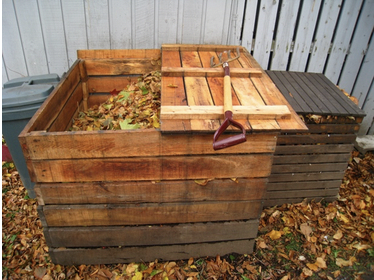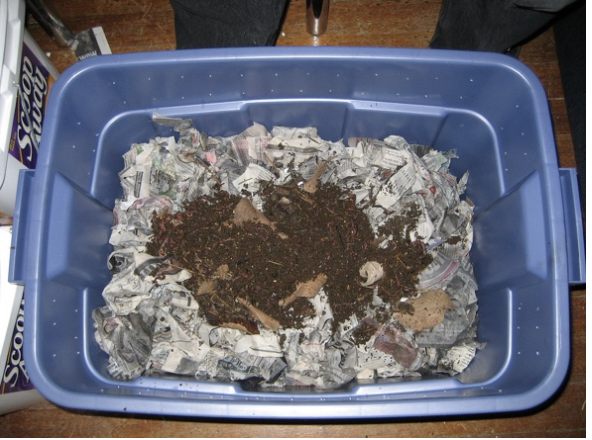Composting
New CommercialWhat is Composting?
Composting is the natural conversion of organic materials into a useable soil amendment. Compost is the by-product of decaying organic matter like vegetable scraps. Material that can be composted (e.g., food scraps and landscape waste) make up 30% of the material we discard.[1] Composting this material instead of sending it to a landfill turns it into a useful resource that builds nutrient-rich organic soil. Vermicomposting is composting facilitated by worms (i.e., generally red wiggler worms Eisenia foetida). The worms help expedite the breakdown of the organic matter; vermicomposting provides a space-saving option for offices and businesses with limited space.[2]

Figure 1 – Outdoor composting container (Source: Flickr solylunafamilia http://www.flickr.com/photos/solylunafamilia/2985709812/)
How to Implement Composting
Organic matter can be collected separately to create compost including kitchen scraps (plant and animal), paper products, wood scraps and grass clippings. Grass clippings can also be left directly on the lawn. This saves time and helps recycle nutrients back into the soil.[3],[4] Depending on the volume and type of waste generated, there are two ways to compost non-lawn waste: choose a pick-up service or choose to compost waste and use it on site. The decision should be Based the decision to compose on how much organic matter you collect regularly, whether the space exists to convert refuse to compost, whether there is a need for nutrient-rich soil on-site (e.g., landscaping, planting, etc.), and whether waste is primarily plant (e.g., leaves and wood chips) or animal matter, and availability of a pick-up service in your area. Some municipalities offer composting drop-off/pick-up services (see Hoboken – Composting). If dropping off materials, be sure to check what waste types are accepted at composting facilities: NJ DEP Solid & Hazardous Waste: Compost Facilities. If composting is not possible on-site, local composting programs or community garden projects often accept items like grass clippings and food waste for their compost operations.[5] If composting in-house, plan for ongoing maintenance of the composting process.
Outdoor Composting Process:
Compost outdoors with either a simple pile in the yard or a compost bin. First, decide on a location for the pile or bin that is shady and relatively dry. Collect roughly equal amounts of nitrogen-rich (e.g., food scraps) and carbon-rich (e.g., dead leaves, twigs) wastes. Add materials to the pile or bin as they are collected while also adding a little water each time. Once the pile is established, add grass clippings, green leaves, and mix to make sure the food scraps are inside the pile. Use the bin lid or a tarp to cover the pile to retain moisture and heat. When the material at the bottom of the pile is rich in organic matter and dark in color, it is ready to use. This could take anywhere from two months to a year, depending on the contents of the compost pile and the outdoor conditions.[6]
Indoor Composting Process:[7]
If outdoor space is limited or unavailable, composting can be done inside on a smaller scale. Purchase or build indoor compost bins, that when managed correctly, do not smell or attract pests.[8] Indoor composting can be performed in one of two ways: anaerobic (i.e., without oxygen) or aerobic (i.e., with oxygen). Choose from anaerobic composters that can be placed on a countertop or under a sink or aerobic composter that use a worm bin. These can either be purchased or made quite easily.
Building a Worm Bin (Vermicomposting)[9]
- In a plastic storage container, place about 8-12 inches of bedding material such as potting soil, leaves, grass clipping, and newspaper strips. Purchase worms, typically red wiggler, to place in the bin. In addition, drill several air holes into the lid of the bin and make sure the bedding is moist and loosely placed in the bin to ensure proper air circulation.
- Add about 1 lb of red worms to the bin.
- Place food scraps, except animal products (e.g., meat, grease, cheese, etc.) under the bedding. Worms can eat about 3 to 3.5 pounds of kitchen waste per week.
- Keep the bin covered to retain heat and moisture. Check the box every day or two for moisture. If the edges begin to look dry, add some water.
- Store the bin in a warm dark place since the worms do not like light and can freeze if it gets too cold.
- Harvest compost when it is a dark, rich color to use in a garden or in potted plants.
Order worm bins or make them a plastic storage bin. For more information on worm bins and composting indoors visit: Rutgers Cooperative Research & Extension

Figure 2 – Typical Worm bin (source: Flickr vees http://www.flickr.com/photos/vees/2150446340/sizes/l/in/photostream/)
Example
Campbell Soup Company Headquarters, Camden, NJ
Campbell initiated a comprehensive waste reduction program, including composting, in 2014. That year, they diverted 2,776 tons of waste from going to the landfill through composting.
Benefits
- Saves money on waste management
- Reduces landfill waste; reducing the production of methane, a greenhouse gas (GHG).
- Improves landscapes through improved soil structure, stabilized pH and suppressing plant diseases[10]
- Provides opportunities to garden and grow produce on-site
Costs
The small up-front costs can be quickly offset by the benefits of waste reduction and the use of compost on-site instead of purchasing fertilizer.
Full size outdoor bins can range in price from $26 – $500. For indoor composting activities, composter prices range from $40 – $300, and small simple collection canisters as low as $20.[11] Worm/vermicompost bins can be made relatively easily[12] or purchased (average $60-100 each)[13] and worms can be purchased for about $20-$40.00/lb (2 lbs to 1 lb of food scraps).[14] Mature compost can also minimize the amount of fertilizer needed, therefore saving on the cost of purchasing fertilizer. Finally, in areas where garbage is collected on a pay per bag basis, reducing the amount of trash by composting food scraps and paper saves money in trash collection fees.[15]
Resiliency
Composting increases local community resilience by reducing stress on the waste management system, emissions from landfill gas and trash burning, and the release of pollutants. Compost enhances soil health, tilth (or physical condition), aeration, and water holding capacity, which support healthy plant and microorganism populations that are more resilient to ecosystem disturbances.[16] Composting also provides stormwater management and erosion control benefits.
[1] US EPA. Composting http://www.epa.gov/epawaste/conserve/rrr/composting/basic.htm (accessed April 7, 2019).
[2] US EPA. Vermicomposting. https://www.epa.gov/reducefoodwaste/types-composting-and-understanding-process#vermi (accessed April 8, 2019).
[3] US EPA. Types of Compost and Understanding the Process. https://www.epa.gov/reducefoodwaste/types-composting-and-understanding-process (accessed April 8, 2019).
[4] NJ DEP. NJ Manual on Composting Leaves and Management of Other Yard Trimmings. VI. Management of Other Yard Wastes: A. Grass Clippings. http://www.state.nj.us/dep/dshw/rrtp/compost/manag.htm (accessed May 5, 2019).
[5] One Green Planet. 7 Things to do with Compost if you don’t Garden. https://www.onegreenplanet.org/lifestyle/things-to-do-with-compost-if-you-dont-garden/
http://www.epa.gov/greenhomes/reducewaste.htm (accessed May 5, 2019).
[6] US EPA, Wastes – Resource Conservation – Reduce, Reuse, Recycle – Composting, http://www.epa.gov/epawaste/conserve/rrr/composting/index.htm (accessed May 5, 2019).
[7] Lower East Side Ecology Center: In-Vessel Composting System. https://www.lesecologycenter.org/programs/compost/ (accessed May 5, 2019).
[8] US EPA. Wastes – Resource Conservation – Reduce, Reuse, Recycle – Composting, http://www.epa.gov/epawaste/conserve/rrr/composting/index.htm (accessed May 5, 2019).
[9] Rutgers Cooperative Extension – Vermicomposting (Worm composting) fact sheet http://njaes.rutgers.edu/pubs/publication.asp?pid=FS805 (accessed May 5, 2019).
[10] Lower East Side Ecology Center. Community Compost Program. https://www.lesecologycenter.org/programs/compost/ (accessed May 5, 2019).
[11] Based on a survey of several manufacturers
[12] US EPA. How to Create and Maintain an Indoor Worm Composting Bin. https://www.epa.gov/recycle/how-create-and-maintain-indoor-worm-composting-bin (accessed May 5, 2019).
[13] Based on a survey of several manufacturers
[14] Based on a survey of several suppliers
[15] US EPA. Sustainable Management of Food Basics. https://www.epa.gov/sustainable-management-food/sustainable-management-food-basics (accessed May 5, 2019).
[16] Platt, Brenda. 2013. “Composting and Community Resilience. Institute for Local Self-Reliance PowerPoint presented for Prince George’s County Planning Department Speaker Series Upper Marlboro, MD, November 20, 2013. https://ilsr.org/wp-content/uploads/2013/12/Composting-Community-Resilience.pdf (accessed May 7, 2019).
Resources
- Institute for Local-Self Reliance
- Lower East Side Ecology Center – Community Compost Program
- Natural Resources Defense Council (NRDC) – Composting is Way Easier Than You Think
- NJ WasteWise – The Economic Benefits of Waste Reduction – WasteWise Case Studies from the Private and Public Sectors
- NYC Master Composter Manual
- Rutgers Agricultural Experiment Station- Rutgers Cooperative Extension
- US Composting Council
- US EPA – How to Create and Maintain an Indoor Worm Composting Bin
- US EPA – Types of Composting and Understanding the Process
